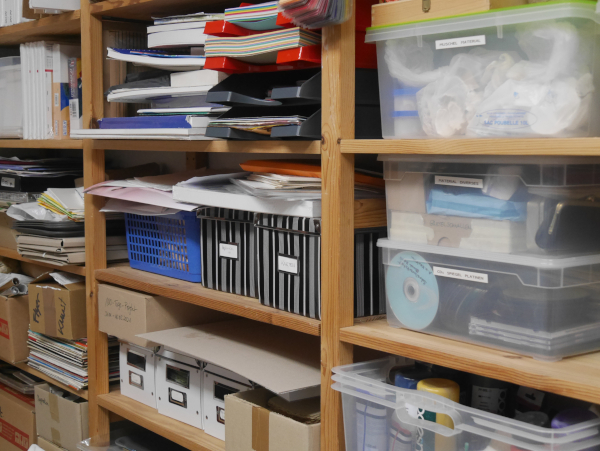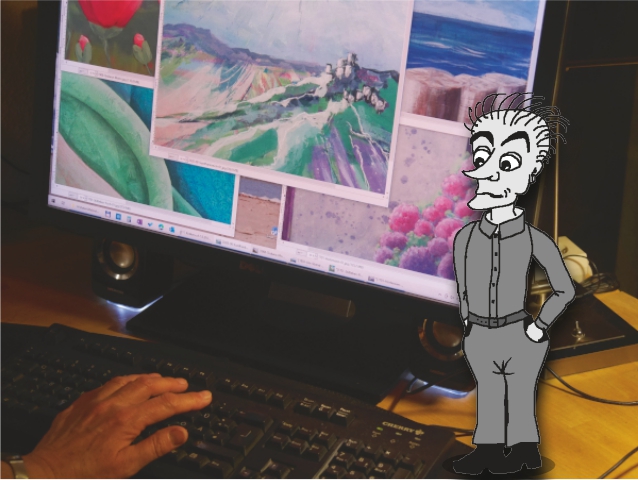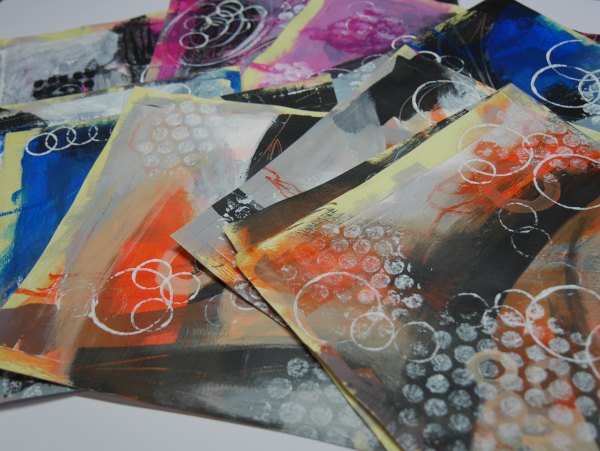Heute stand ich vor dem geöffneten Kleiderschrank und habe mir die Stapel selbst gestrickter Pullover angeschaut. Viele Pullover. Manche bestimmt schon zehn Jahre alt, andere erst vor kurzem fertig geworden. Ich stricke gerne und ständig und Handgemachtes ist haltbar. Also wird mein Kleiderschrank immer voller.
Ähnlich geht es mir auch mit den gesammelten Materialien, Notizen und Künstler-Websites, von denen ich beim letzten Mal erzählt habe. Im Laufe der Jahre häufen sie sich an und irgendwann weiß ich gar nicht mehr, was ich da so alles horte. Geschweige denn nutze ich sie – und das war ja der eigentliche Zweck des Sammelns. Zeit, einen kritischen Blick darauf zu werfen.
Sichten und entscheiden
Beginnen wir mit den Websites. Ich klicke nacheinander auf jedes Lesezeichen und schaue mir in Ruhe an, was ich dort aktuell finde. Frage mich, warum ich diese Website so interessant fand, dass ich sie mir merken wollte. Gefallen mir die Werke, die ich dort sehe immer noch?
Wenn ja, frage ich weiter: warum? Was finde ich an den Arbeiten spannend? Sind es die Farben, die Bildkompositionen, die verwendeten Techniken? Ich versuche, so konkret wie möglich zu sein und mache mir Notizen.
Wenn ich keine Ahnung habe, warum ich diese Website überhaupt abgespeichert habe, oder wenn mich die Bilder nicht (mehr) ansprechen, kann ich das Lesezeichen ohne weiteres löschen.
Ähnlich gehe ich mit den Fotos von gesammelten Inspirationen vor. Hier kann ich direkt auf den Blättern meine Notizen machen. Kann Eindrücke in Stichworten festhalten und aufschreiben, was genau ich von diesem Werk für meine eigenen Arbeit mitnehmen möchte.
Was, wenn mir das Bild nichts sagt? Dann brauche ich mich nicht weiter damit zu beschäftigen, es darf gerne weg.
Und die Material-Sammlung? Das ist – zumindest für mich – der schwierigste Bereich. Weil er so vielfältig ist. Weil ich mich so schwer trennen kann und denke: Wenn ich nur drei alte Straßenkarten behalte, könnte das zuwenig sein für eine größere Bilderserie. Oder: die vielen Bänder und Kordeln sind so unterschiedlich in Farbe, Material und Länge, wie soll ich da sinnvoll auswählen?
Das Hauptproblem: der Konjunktiv! All diese Dinge hebe ich auf, weil sie für irgendwelche Projekte genutzt werden könnten. Weil ich sie in Collagen verwenden könnte. Weil ich aus ihnen Objekte erstellen könnte. Keine konkreten Projekte, Collagen, Objekte – nur Möglichkeiten.
Aber genau diese Möglichkeiten sind es, die mich an den Dingen festhalten lassen.
Einzige Chance, nicht im Chaos unterzugehen: Sortieren, gruppieren, in Kisten verstauen und diese beschriftet auf dem Speicher lagern. (Ich weiß, das ist keine Dauerlösung!) Dann ist wieder mehr Platz im Atelier und ich habe dort Zugriff auf genau die Sachen, die ich gerade für meine Arbeit brauche.
Fazit:
- Den Fundus reduzieren auf Gesammeltes, das aktuell immer noch passt.
- Gedanken rund um das “Warum” helfen, klarer zu werden in dem, was mich im Einzelnen daran interessiert.
- Gemeinsamkeiten entdecken in der Auswahl von Websites und Fotos; diese zeigen mir einen Weg, meine eigene Arbeit weiterzuentwickeln.
- Und ganz wichtig: Die Sammlung regelmäßig sichten, nicht nur um auszusortieren, sondern auch um sich Inspiration zu holen.
Where do ideas come from (3): Keep an overview of the pool
Today I stood in front of the open wardrobe and looked at the stacks of self-knitted sweaters. Lots of sweaters. Some are probably ten years old, others only recently finished. I like to knit all the time and hand-made things are durable. So my closet keeps getting full.
I feel the same way with the collected materials, notes and artist websites that I told you about last time. Over the years they pile up and at some point I don’t even know what I’m hoarding. Let alone use them – and that was the real purpose of collecting. Time to take a critical look.
Look through and decide
Let’s start with the websites. I click on each bookmark one after the other and take my time to take a look at what I can currently find there. Wonder why I found this website so interesting that I wanted to remember it. Do I still like the works I see there?
If so, I continue to ask: why? What do I find exciting about the work? Is it the colors, the composition, the techniques used? I try to be as specific as possible and take notes.
If I have no idea why I saved this website at all, or if the images don’t appeal to me (anymore), I can easily delete the bookmark.
I proceed in a similar way with the photos of collected inspirations. Here I can make my notes directly on the sheets. Can capture impressions in key words and write down what exactly I would like to take with me from this work for my own work.
What if the picture says nothing to me? Then I don’t need to deal with it any further, it can leave.
And the material collection? That is – at least for me – the most difficult area. Because it is so diverse. Because I find it so difficult to let go and think: If I only keep three old street maps, that might not be enough for a larger series of paintings. Or: the many ribbons and cords are so different in color, material and length, how should I choose rationally?
The main problem: the subjunctive! I keep all these things because they could be used for any kind of project. Because I could use them in collages. Because I could make objects out of them. No concrete projects, collages, objects – just possibilities.
But it is precisely these possibilities that make me hold onto things.
The only chance not to get lost in the chaos: Sorting, grouping, stowing in boxes and storing them in the attic, labeled. (I know this is not a permanent solution!) Then there is more space in the studio and I have access to exactly those things that I need for my work at the moment.
Conclusion:
- Reduce the pool to a collection that currently still fits.
- Thoughts about the “why” help to become clearer about what interests me in detail.
- Discover similarities in the choice of websites and photos; these show me a way to develop my own work further.
- And very important: Sift through the collection regularly, not only to sort it out, but also to get inspiration.


